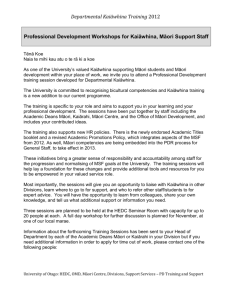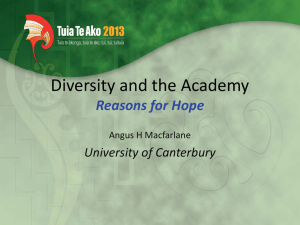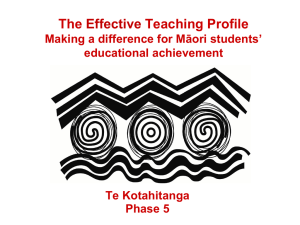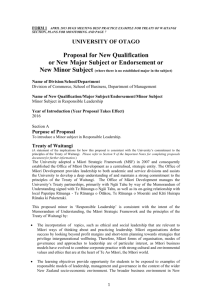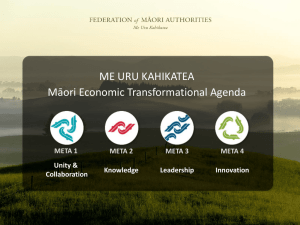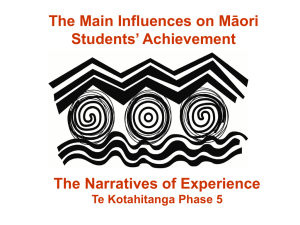Extract from Te Kaupapa Tikanga Rua Bicultural Development (1986)
advertisement
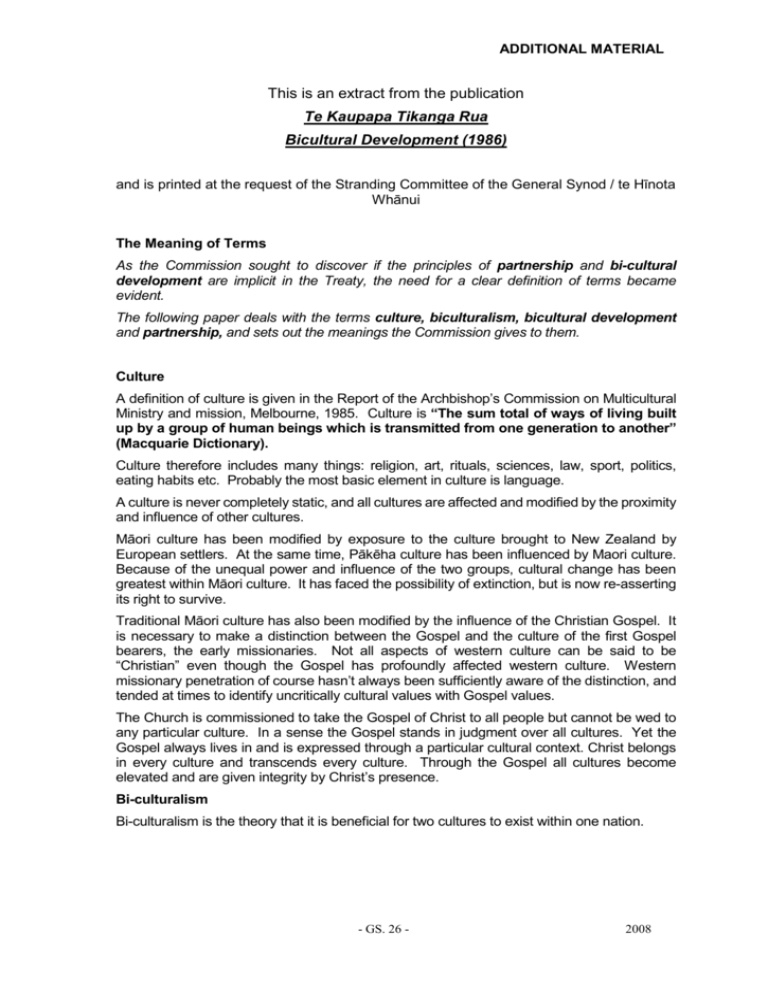
ADDITIONAL MATERIAL This is an extract from the publication Te Kaupapa Tikanga Rua Bicultural Development (1986) and is printed at the request of the Stranding Committee of the General Synod / te Hīnota Whānui The Meaning of Terms As the Commission sought to discover if the principles of partnership and bi-cultural development are implicit in the Treaty, the need for a clear definition of terms became evident. The following paper deals with the terms culture, biculturalism, bicultural development and partnership, and sets out the meanings the Commission gives to them. Culture A definition of culture is given in the Report of the Archbishop’s Commission on Multicultural Ministry and mission, Melbourne, 1985. Culture is “The sum total of ways of living built up by a group of human beings which is transmitted from one generation to another” (Macquarie Dictionary). Culture therefore includes many things: religion, art, rituals, sciences, law, sport, politics, eating habits etc. Probably the most basic element in culture is language. A culture is never completely static, and all cultures are affected and modified by the proximity and influence of other cultures. Māori culture has been modified by exposure to the culture brought to New Zealand by European settlers. At the same time, Pākēha culture has been influenced by Maori culture. Because of the unequal power and influence of the two groups, cultural change has been greatest within Māori culture. It has faced the possibility of extinction, but is now re-asserting its right to survive. Traditional Māori culture has also been modified by the influence of the Christian Gospel. It is necessary to make a distinction between the Gospel and the culture of the first Gospel bearers, the early missionaries. Not all aspects of western culture can be said to be “Christian” even though the Gospel has profoundly affected western culture. Western missionary penetration of course hasn’t always been sufficiently aware of the distinction, and tended at times to identify uncritically cultural values with Gospel values. The Church is commissioned to take the Gospel of Christ to all people but cannot be wed to any particular culture. In a sense the Gospel stands in judgment over all cultures. Yet the Gospel always lives in and is expressed through a particular cultural context. Christ belongs in every culture and transcends every culture. Through the Gospel all cultures become elevated and are given integrity by Christ’s presence. Bi-culturalism Bi-culturalism is the theory that it is beneficial for two cultures to exist within one nation. - GS. 26 - 2008 ADDITIONAL MATERIAL Bi-culturalism is the opposite of assimilation and may take at least two different forms. Apartheid is a distorted form of Bi-culturalism inconsistent with the Gospel. Bi-culturalism can allow for mutual dependence and responsibility, with a maximum level of cultural interaction and sharing. The Treaty laid down the foundation for the existence together of two main cultural groups – Māori and Pākēha –within the one nation. Bi-culturalism is a term that recognizes the presence and importance of these two main cultures in New Zealand. However there are also many other cultures represented in New Zealand and even sub-cultures within each of the two dominant groupings. Because of this, there are those who prefer to speak of New Zealand as multi-cultural society. While this is legitimate it can be used to mask the primary reality expressed in the Treaty of Waitangi, and the obligation to live by its principles. Bi-culturalism can also refer to the ability of a person to embrace two cultures and “be at home” in both. Up until recently, bi-culturalism in this sense has been forced on Māori people but not expected of Pākēha people. The Macquarie Dictionary defines “multi-culturalism” as “the theory that it is beneficial to society to maintain more than one culture within its structure”. The definition emphasizes the value of cultural diversity to a nation. If New Zealanders can come to such a positive view of cultural relationships and regard our two main cultures, (and other cultural groups), as potentially enriching to both individuals and to the total life of the nation, this would provide the best basis for social well being and nationhood. Bi-cultural development: Bi-cultural development is the process whereby two cultures grow and develop within one nation in a spirit of mutual respect and responsibility. Māori culture and Pākēha culture will be encouraged to develop as integral entities but also to intertwine and overlap. Bi-cultural development recognizes that the majority culture is required to take positive steps to protect and encourage minority interests and needs, for without such a commitment a minority culture may not be able to survive. Applied to the Church, bi-cultural development means taking steps to ensure that the Gospel of Christ takes root in, and is expressed through two different cultural forms within the one provincial or national Church. It witnesses to the enriching diversity of God’s creation, and at the same time recognizes the essential unity of all of creation in Christ. Bi-cultural development is also the process whereby individuals identified with one culture, grow in understanding and experience of the other. Such a development for the Christian is an expression of neighbourly love. Bi-cultural development is an enriching process for individuals, and for the church and for the nation. Partnership Partnership involves co-operation and interdependence between distinct cultural or ethnic groups within one nation. It implies that Māori and Pākēha have gifts to give and receive from one another and that nationhood is best established when both partners are valued and respected and share fairly in decision making and the resources of the nation. Applied to the Church, the principle of partnership means that each cultural group or people is accorded the same dignity in Christ, make their distinctive contribution to the common life of the Church and each encourages and supports the other. There is mutual responsibility and inter-dependence within the Body of Christ. - GS. 27 - 2008 ADDITIONAL MATERIAL A possible consequence of partnership is homogenization. Both cultural groups are modified by the influence of each on the other and a new culture evolves that is neither Māori nor Pākēha. New Zealand can be described as “one nation with three histories – Māori, Pākēha and one in the making”. The emergence of a new “kiwi culture” may be the inevitable long term prospect but the Commission believes that this should not be accepted as a policy goal. Healthy social development is most likely to occur when there is respect and trust between the partners, where there is creative interaction and communication, and where the pressures to conform to any particular culture are minimized. While the definitions in this paper have described mainly relationships between cultural groups, the Commission recognizes that for effective and constructive partnership to exist much depends on the existence of not only helpful structures but also mature individuals. The Church needs to ensure that its structures encourage respect and justice for all, and that its members “put on Christ” and show that the quality of love “with which He loved us”, if the principle of partnership is to become truly incarnate in its life. Clarification of Māori Terms frequently used. In the course of receiving numerous submissions, the commission became aware of the need to explain and to clarify certain Māori terms used in the communication between the cultural groups. The Commission is able to include in its report notes on the following:MĀORI: a) The term applied to the indigenous Polynesian of Aotearoa. b) The term applied by themselves to the Polynesian people of the Pacific. 1. “A word which they apply to themselves as their peculiar name” – Taylor 1855. 2. Williams – “ordinary” – “normal” – “Native” – “aborigine” – e.g. Wai-Māori = fresh water, Wai-Moriori = fresh water. 3. A word signifying anything that is native or indigenous. PĀKĒHA: Beings resembling “man” but fair to look at. The term applied to native born or acculturated New Zealanders of European descent. 1. Derives from “Pāke” – fair or white cf. “Pāke/ho” = limestone, white clay. 2. Alternatively derives from “Pākēha” beings with fair skin. Applied to fairy people in mythology. NOTE: The story that the word “Pākēha” is a corruption of an English swear word is merely a “barroom” legend which was attributed to an eminent Maori politician who was not only blessed with an Irish ancestry but had more than his fair share of the blarney humour of Ole Ireland. - GS. 28 - 2008 ADDITIONAL MATERIAL NGA MĀORI O NGA MOUTERE The Māori name for the people of the Pacific. It is common to hear reference to Peoples in other parts of the Pacific by Maori elders as “Nga Māori o te Moana-nui-a-Kiwa”, and “Nga Māori o Nga Moutere”. The use of the ethnographic term “Polynesian” is discouraged as a reference solely to the people of the Pacific. TANGATA WHENUA: Denotes the people who belong to a particular place – “The people of the Land”. 1. A word whose valid application is limited to Pākēha people who “belong” in a particular place or area. 2. The host people of a marae or district for the manuhiri or visitors. WHENUA: The word for “land”. 1. Used also for “after birth”. In earlier times, less frequently today, the after birth was always returned to the land and was buried in a traditional place. There is a direct connection between this custom and the notion of “Tangata Whenua”. 2. Conceptually there also seems to be some similarity to the filial regard the British have for their own “motherland” or the German for his (“her”) “Fatherland”. -A Māori living in Britain may regard it as his (“her”) home but could never claim it as “Motherland”. -The Biblical connection between Tangata and Whenua (Compare Genesis 2) “God formed man out of the dust and breathed into his nostrils the breath of life.” -In the final rites we are returned to Mother Earth with the words “From dust thou art to dust thou returneth.” MANUHIRI: Visitor or guest in relation to “tangata whenua” or host. 1. Tribal connotation applies also in this case although in a converse way to when used in reference to tangata whenua. 2. People are always guests or manuhiri when visiting outside their tribal boundaries and kawa. 3. People are also guests or manuhiri when visiting their kin of other subtribes. 4. In nearly every Māori situation Ngati Pākēha are manuhiri or sometimes “tauiwi” i.e. “outsider” and less favourably, “rawaho” or intruder, or outsider. 5. Inside his own kawa and on his own territory the Pākēha is the tangata whenua or host and others are his manuhiri or may be rawaho (intruders). 6. Such places and occasions as the opening of Parliament make his territory clearly discernable and where his kawa is strictly observed. 7. Generally the use of the terms tangata whenua and manuhiri are reserved for special occasions and the word ‘Pākēha” or Ngati Pākēha should be the term most commonly used when Maori New Zealanders refer to pink New Zealanders. - GS. 29 - 2008 ADDITIONAL MATERIAL KAWA: -Protocol – procedure -Each tribe has developed its own Kawa and insists upon its strict observance both by the tangata whenua themselves and by the manuhiri. -A breach of the Kawa may sometimes lead to expulsion and in the earlier days to battle or death or cursing. -Each tribe therefore respects the Kawa of another and demands the same from others in return. -The Kawa of Ngati Pākēha should therefore receive the same respect by the manuhiri. The manuhiri should always be and act the “manuhiri” when invited to participate in a Pākēha occasion. -To do this, is what is called being a Rangatira (a person of the highest breeding). - GS. 30 - 2008



